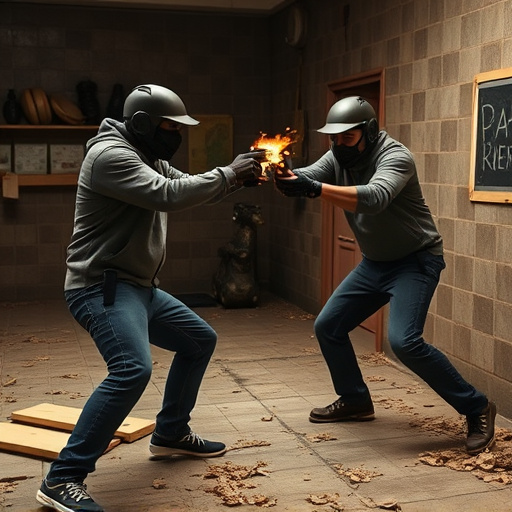Pepper spray, a popular self-defense tool, temporarily disables assailants through chemical agents targeting eyes and airways. Widely used by civilians and law enforcement due to its non-lethal nature, effective deployment requires understanding its mechanism and having readily available First Aid Supplies for Pepper Spray, including eye washes, neutralizers, bandages, antiseptics, hydrocortisone creams, antihistamines, and clear medical instructions. After exposure, quick actions like moving to fresh air and using these supplies are crucial; immediate medical attention is recommended, especially for those with pre-existing conditions, to minimize symptoms and ensure the best outcome.
- Understanding Pepper Spray: A Quick Overview
- The Science Behind Pepper Spray's Effectiveness as a Deterrent
- Essential Components of First Aid Supplies for Pepper Spray Exposure
- Practical Applications: When and How to Use Pepper Spray Defense Mechanisms
- Safety Measures and Post-Exposure Care: Preventing and Managing Complications
Understanding Pepper Spray: A Quick Overview
Pepper spray, a powerful deterrent and defense mechanism, has become a common tool for self-defense in today’s world. It is a type of chemical agent designed to cause temporary but intense irritation, disorientation, and discomfort when sprayed into the eyes and respiratory system of an assailant. This non-lethal weapon is widely used by law enforcement agencies and civilians alike due to its effectiveness in diffusing potentially dangerous situations without causing permanent harm.
Understanding how pepper spray works is essential when considering it as a personal safety measure. First Aid Supplies for Pepper Spray are crucial, as they include eye wash solutions, respiratory support, and protective gear. When deployed, the spray creates a burning sensation, narrowing the assailant’s vision and making it difficult to breathe. This temporary disability can provide the user with precious time to escape or seek help. Knowing how to use and access these supplies promptly is vital for effective self-defense against pepper spray attacks.
The Science Behind Pepper Spray's Effectiveness as a Deterrent
Pepper spray, a powerful deterrent, has gained widespread recognition as a crucial tool for personal safety. Its effectiveness lies in its unique ability to disrupt an attacker’s vision and breathing, providing a critical window of opportunity for escape or assistance. The active ingredient, capsaicin, is extracted from chili peppers and targets the body’s sensory neurons, leading to temporary blindness and severe irritation. This disruption in an assailant’s senses significantly increases the chances of a victim’s survival.
In the realm of first aid supplies for pepper spray, understanding its science is paramount. The spray creates a chemical reaction with the eyes and respiratory system, causing them to become temporarily disabled. This short-term incapacitation allows victims to activate emergency services or flee from dangerous situations. The impact of pepper spray deterrents has been widely studied, demonstrating their potential to prevent and reduce violence in various settings, from personal self-defense to crowd control during protests.
Essential Components of First Aid Supplies for Pepper Spray Exposure
In the event of pepper spray exposure, having adequate first aid supplies is crucial. The primary components include eye wash solutions to irrigate and flush out any residual spray from the eyes, ensuring no long-term damage occurs. Additionally, neutralizing agents like sodium bicarbonate or specific pepper spray neutralizers are essential to counteract the effects of capsaicin, the active ingredient in pepper spray.
In your kit, include bandages and gauze to cover and protect affected areas, along with antiseptic wipes or solutions for cleaning wounds. Hydrocortisone creams or antihistamines can help alleviate skin irritation and itching. It’s also beneficial to have a well-stocked emergency contact list and clear instructions on when to seek medical attention, as severe reactions may require professional treatment.
Practical Applications: When and How to Use Pepper Spray Defense Mechanisms
In practical terms, pepper spray serves as a powerful defense mechanism when facing potential threats, especially in situations where personal safety is at risk. It’s a non-lethal option that temporarily disorientates and incapacitates an aggressor, providing the user with valuable time to escape or call for help. The strategic use of pepper spray can be life-saving, particularly in high-risk environments such as law enforcement operations, security patrols, and personal self-defense scenarios.
When utilizing pepper spray as a defense mechanism, it’s crucial to have a solid understanding of its application. Users should aim for the eyes, nose, and mouth of the assailant, ensuring proper ventilation to maximize its effectiveness. First Aid Supplies for Pepper Spray, including eye wash solutions and neutralizing agents, are essential accessories to have on hand. Proper training in its use is paramount to ensure safety and compliance with legal guidelines, allowing individuals to defend themselves confidently and responsibly.
Safety Measures and Post-Exposure Care: Preventing and Managing Complications
After exposure to pepper spray, proper safety measures and post-exposure care are crucial in preventing and managing complications. If a person is affected by pepper spray, the first step is to move them to an area with fresh air immediately. This dilutes the concentration of capsaecin, the active ingredient in pepper spray, reducing irritation and discomfort. It’s essential to have First Aid Supplies for Pepper Spray readily available in public spaces and workplaces where pepper spray usage is a risk. These kits should include items like eye irrigation solutions, neutralizing eye washes, and absorbent materials to help alleviate symptoms.
In addition to proper ventilation, seeking medical attention is vital, especially for individuals with pre-existing respiratory conditions or sensitive skin. First responders and healthcare professionals play a significant role in managing exposure by using specialized equipment and knowledge to irrigate the eyes and body, neutralize the spray’s effects, and provide comfort to the affected individual. Quick action can significantly minimize the impact of pepper spray and ensure the best possible outcome.
